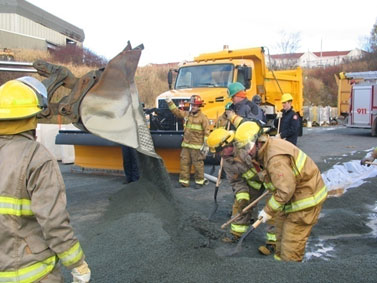
By Bruce Lake
According to the 2012 edition of the Emergency Response Guidebook (ERG), a small spill consists of 55 gallons (208 liters) or less of a liquid or 661 pounds (300 kilograms) or less of a solid. A typical steel oil drum holds approximately 55 gallons. Thirteen, 50-pound bags of potatoes weigh 10 pounds less than 661 pounds . Depending on your response model, the first-arriving company will have to operate independently for varying amounts of time. During this period, small spills are routinely mitigated with nothing more than the equipment that is aboard a single apparatus. Large spills, more than 55 gallons (208 liters) or more than 661 pounds (300 kilograms) are much more challenging and are typically beyond the capacity of a single unit. While waiting for support to arrive, the incident commander (IC) must balance safety against realistic response efforts. Tactical priorities that are commonly applied at structural fires can be used to guide response efforts at spill incidents. These priorities include life safety, hazard control, and protecting the environment.
Life Safety
Life safety at a hazmat incident begins with a safe assessment of the situation. Resist the urge to rush in. Getting too close too soon may put you at unnecessary risk. Containers may explode violently when exposed to excessive heat or when contents are exposed to foreign substances. Hazardous gases such as propane are frequently compressed into a liquid state for more efficient storage and transport. If a container of these chemicals is compromised, the cold liquid inside will turn into a gas as soon as the product makes contact with warm air. There may be a visible white cloud of condensation at the breach location. As the product moves away from the container, it will become invisible. Air monitoring will be required to determine if concentrations of invisible flammable or toxic vapors are safe, unsafe, or dangerous.
Be on the lookout for containers with corrosives markings. Vapors produced from corrosive materials can destroy a gas monitor and damage human skin. Structural firefighting clothing offers little if any protection from high concentrations of corrosive vapors under pressure. Chlorine and anhydrous ammonia are common chemicals that can produce corrosives hazards. Chlorine is commonly used to destroy etiological hazards at water treatment facilities and anhydrous ammonia is commonly used as a refrigerant and fertilizer.
Stage your apparatus a safe distance away from the hazard area, preferably uphill and upwind. Avoid contact with any released materials. Try to identify the material by collecting information from all available sources such as placards, vehicle markings, container type, vehicle shape, witness reports, driver reports, shipping papers, and observed chemical reactions.
Use the current edition of the ERG to determine the hazard exclusion zone and downwind protective action distances, if necessary. Keep the hazard area clear of curious civilians and first responders. Non-ambulatory victims may need to be removed via a grab-and-go or by extrication under hoseline protection. During rescue operations, wear full protective equipment, including respiratory protection. Civilians and responders who come into contact with hazardous materials may require emergency decontamination. This can be performed on scene by removing contaminated clothing and or flushing with copious amounts of low-pressure water.
RELATED TRAINING: ARE ALL CHEMICAL SPILLS OR RELEASES “EMERGENCIES”? | EVACUATING AT HAZ-MAT INCIDENTS
Hazard Control
After the IC has confirmed the identity of the hazardous materials involved and has dealt with any immediate life safety issues, the next priority is hazard control. Hazard control consists of two parts: Part A, prevent the situation from getting worse, and Part B, eliminate the hazard. Look for quick and simple actions that can immediately improve the situation, such as activating an emergency stop control, turning a valve off, placing a container underneath a leak, throwing down absorbent material, or requesting the immediate assistance of a hazardous materials or public works crew. Quickly containing a spill to a small area reduces the contamination potential and makes cleanup and recovery much easier. Practical spill control options will be detailed later in the article.
An IC should never task an assignment to personnel who lack the required protective equipment, training, or resources necessary to get the job done. Regardless of your experience and training, specialized resources are usually needed to eliminate spill hazards of all sizes. Do not delay requests for assistance.
Protecting the Environment
Protecting the environment is often conducted simultaneously with hazard control. Prevent spills from entering storm drains, sewers, or waterways (See Photo 1). A containment barrier stops the movement of the product while a diversion barrier controls where the product flows (See Photo 2). These barriers are commonly constructed from dirt, sand, or other available materials to prevent dangerous chemicals from entering sensitive areas. When constructing barriers, don’t stand on the spill side–keep the barrier between you and the spill (See Photo C). Try to predict the flow path of the product and strategically place barriers. Sometimes the quantity of product is beyond the capability of a single unit. In these situations, evacuate and isolate as required while awaiting reinforcements. Every jurisdiction has unique spill reporting requirements. Confirm with your authority having jurisdiction the specific information that you are mandated to report. Reporting spills and requesting assistance quickly will help reduce negative environmental impact.
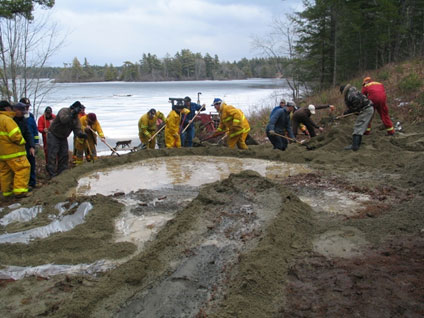
(1)
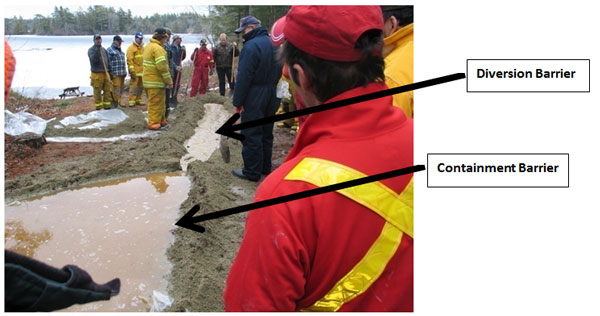
(2)
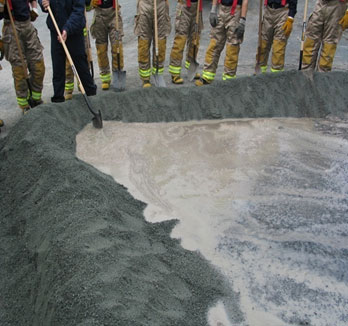
(3)
RELATED TRAINING: Hazmat Survival Tips: 10 Initial Response Considerations for First Responders | Hazardous Materials Incident Size-Up
Practical Spill Control Options
Many apparatus contain the following items: shovel, plastic tarp, rope, absorbent material, various containers, and multiple sizes of hose. At small spills, shovels can be used to build containment or diversion barriers from sand or dirt. Barriers are often constructed in the shape of circles or the letters “U” or “V”. U-shaped barriers are primarily used to catch and contain product down grade. U-shaped barriers can also be reversed to protect the entrances of storm drains next to sidewalks. V-shaped barriers are used to stop fast flowing spills down grade. The point of the “V” can be used as a collection point for an industrial vacuum truck. Circle-shaped barriers are constructed to contain a spill or protect a specific area. Shovels can also be used to scoop up product and place it into a container. At large spills, bulk amounts of sand or dirt will be needed to build barriers. Heavy machinery will be needed to move bulk material (See Photo 4).

(4)
Plastic tarps are very versatile. Tarps can be used to construct traditional catch basins. Ditches can be lined with tarps to contain product. Tarps can cover sewer and storm drain openings before dirt barriers are constructed. Rope can be used to support improvised catch basins (See Photo 5) or reinforce others barrier such as dams. Most apparatus carry a small amount of absorbent material such as kitty litter or spill pads. These materials can be used to soak up small hydrocarbon spills. They can also be used to build or reinforce containment and diversion barriers. Containers of any size or shape can be used to hold leaking materials. A charged hoseline can be used to build a containment boom, disperse vapors with a fog pattern, and apply a foam blanket (if you have foam capability).
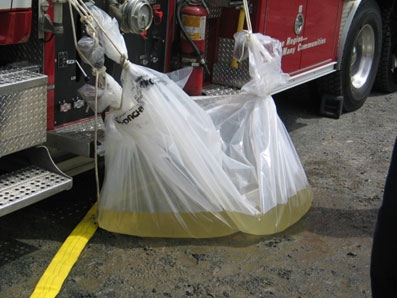
(5)
Finally, remember to take advantage of all available resources on scene. Scrap materials can be used to build and reinforce barriers. Operators of dump trucks and backhoes can be asked to provide assistance. Even the wooden door chocks carried on your helmet can be used. Leaking diesel saddle tanks and 55-gallon drums are commonly plugged with nothing more than a wooden wedge.
Leave the Carcinogens on Scene
Firefighters have a higher rate of cancer than the general public. This is because of repeated and unprotected exposure to dangerous substances. Don’t bring carcinogens or chemical residue back to the fire station. Decontaminate your turnout gear and tools on scene (See Photo 6). Flushing equipment with a handline on scene will remove some contamination. Double bag contaminated clothing and tools for transport until a detailed cleaning can be conducted. Wash turnout gear and uniforms in a designated washing machine. Take a shower after the incident. Don’t contaminate your apparatus, fire station, co-workers, personal vehicle, or family.
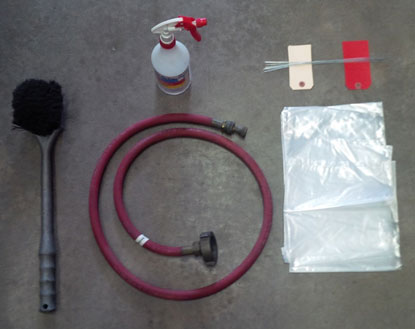
(6)
Depending on your situation, first-due companies will operate independently for various lengths of time. During this period, the IC must balance safety against realistic response efforts. Life safety, hazard control and protecting the environment are tactical priorities that can be used to guide decision making at spill incidents. The ability to adapt resources to the situation is an important skill that is acquired through years of training and experience. Structural firefighting equipment has multiple applications. Take advantage of all resources on scene. Do not delay any requests for assistance or specialized support. Now go have a look at the equipment on your apparatus and preplan your spill response.
 Bruce Lake is a training officer with Halifax Regional Fire and Emergency in Nova Scotia, Canada. He is a Level 2 Firefighter, Level 3 Fire Service Instructor, and a Level 2 Fire Officer. Lake is a veteran hazardous materials technician and is a graduate of the Fire Service Management Program at Dalhousie University. Prior to joining the fire service, Lake served in the Canadian Army as a Nuclear, Biological, and Chemical Defence Officer.
Bruce Lake is a training officer with Halifax Regional Fire and Emergency in Nova Scotia, Canada. He is a Level 2 Firefighter, Level 3 Fire Service Instructor, and a Level 2 Fire Officer. Lake is a veteran hazardous materials technician and is a graduate of the Fire Service Management Program at Dalhousie University. Prior to joining the fire service, Lake served in the Canadian Army as a Nuclear, Biological, and Chemical Defence Officer.

